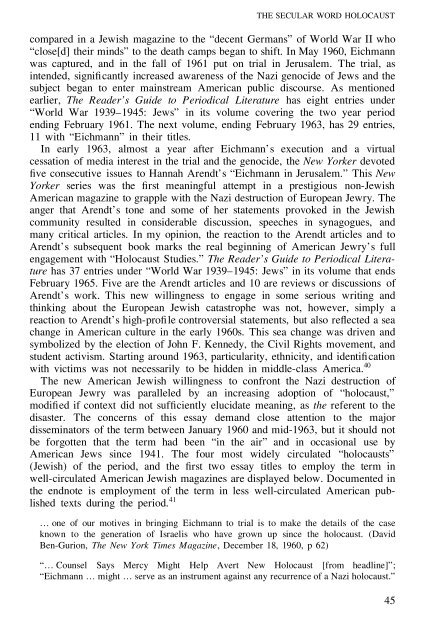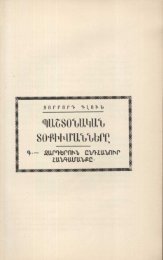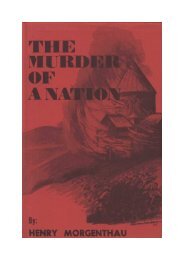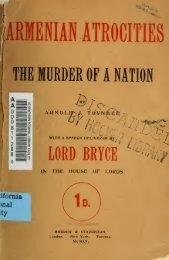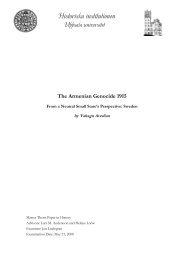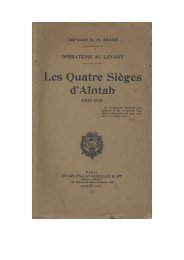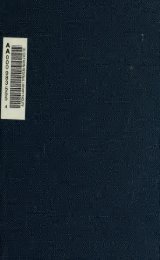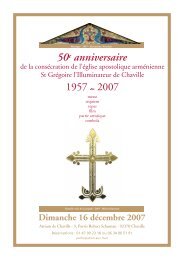The secular word HOLOCAUST: scholarly myths, history, and 20th ...
The secular word HOLOCAUST: scholarly myths, history, and 20th ...
The secular word HOLOCAUST: scholarly myths, history, and 20th ...
Create successful ePaper yourself
Turn your PDF publications into a flip-book with our unique Google optimized e-Paper software.
THE SECULAR WORD <strong>HOLOCAUST</strong>compared in a Jewish magazine to the “decent Germans” of World War II who“close[d] their minds” to the death camps began to shift. In May 1960, Eichmannwas captured, <strong>and</strong> in the fall of 1961 put on trial in Jerusalem. <strong>The</strong> trial, asintended, signi cantly increased awareness of the Nazi genocide of Jews <strong>and</strong> thesubject began to enter mainstream American public discourse. As mentionedearlier, <strong>The</strong> Reader’s Guide to Periodical Literature has eight entries under“World War 1939–1945: Jews” in its volume covering the two year periodending February 1961. <strong>The</strong> next volume, ending February 1963, has 29 entries,11 with “Eichmann” in their titles.In early 1963, almost a year after Eichmann’s execution <strong>and</strong> a virtualcessation of media interest in the trial <strong>and</strong> the genocide, the New Yorker devoted ve consecutive issues to Hannah Arendt’s “Eichmann in Jerusalem.” This NewYorker series was the rst meaningful attempt in a prestigious non-JewishAmerican magazine to grapple with the Nazi destruction of European Jewry. <strong>The</strong>anger that Arendt’s tone <strong>and</strong> some of her statements provoked in the Jewishcommunity resulted in considerable discussion, speeches in synagogues, <strong>and</strong>many critical articles. In my opinion, the reaction to the Arendt articles <strong>and</strong> toArendt’s subsequent book marks the real beginning of American Jewry’s fullengagement with “Holocaust Studies.” <strong>The</strong> Reader’s Guide to Periodical Literaturehas 37 entries under “World War 1939–1945: Jews” in its volume that endsFebruary 1965. Five are the Arendt articles <strong>and</strong> 10 are reviews or discussions ofArendt’s work. This new willingness to engage in some serious writing <strong>and</strong>thinking about the European Jewish catastrophe was not, however, simply areaction to Arendt’s high-pro le controversial statements, but also re ected a seachange in American culture in the early 1960s. This sea change was driven <strong>and</strong>symbolized by the election of John F. Kennedy, the Civil Rights movement, <strong>and</strong>student activism. Starting around 1963, particularity, ethnicity, <strong>and</strong> identi cationwith victims was not necessarily to be hidden in middle-class America. 40<strong>The</strong> new American Jewish willingness to confront the Nazi destruction ofEuropean Jewry was paralleled by an increasing adoption of “holocaust,”modi ed if context did not suf ciently elucidate meaning, as the referent to thedisaster. <strong>The</strong> concerns of this essay dem<strong>and</strong> close attention to the majordisseminators of the term between January 1960 <strong>and</strong> mid-1963, but it should notbe forgotten that the term had been “in the air” <strong>and</strong> in occasional use byAmerican Jews since 1941. <strong>The</strong> four most widely circulated “holocausts”(Jewish) of the period, <strong>and</strong> the rst two essay titles to employ the term inwell-circulated American Jewish magazines are displayed below. Documented inthe endnote is employment of the term in less well-circulated American publishedtexts during the period. 41… one of our motives in bringing Eichmann to trial is to make the details of the caseknown to the generation of Israelis who have grown up since the holocaust. (DavidBen-Gurion, <strong>The</strong> New York Times Magazine, December 18, 1960, p 62)“… Counsel Says Mercy Might Help Avert New Holocaust [from headline]”;“Eichmann … might … serve as an instrument against any recurrence of a Nazi holocaust.”45


